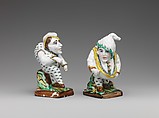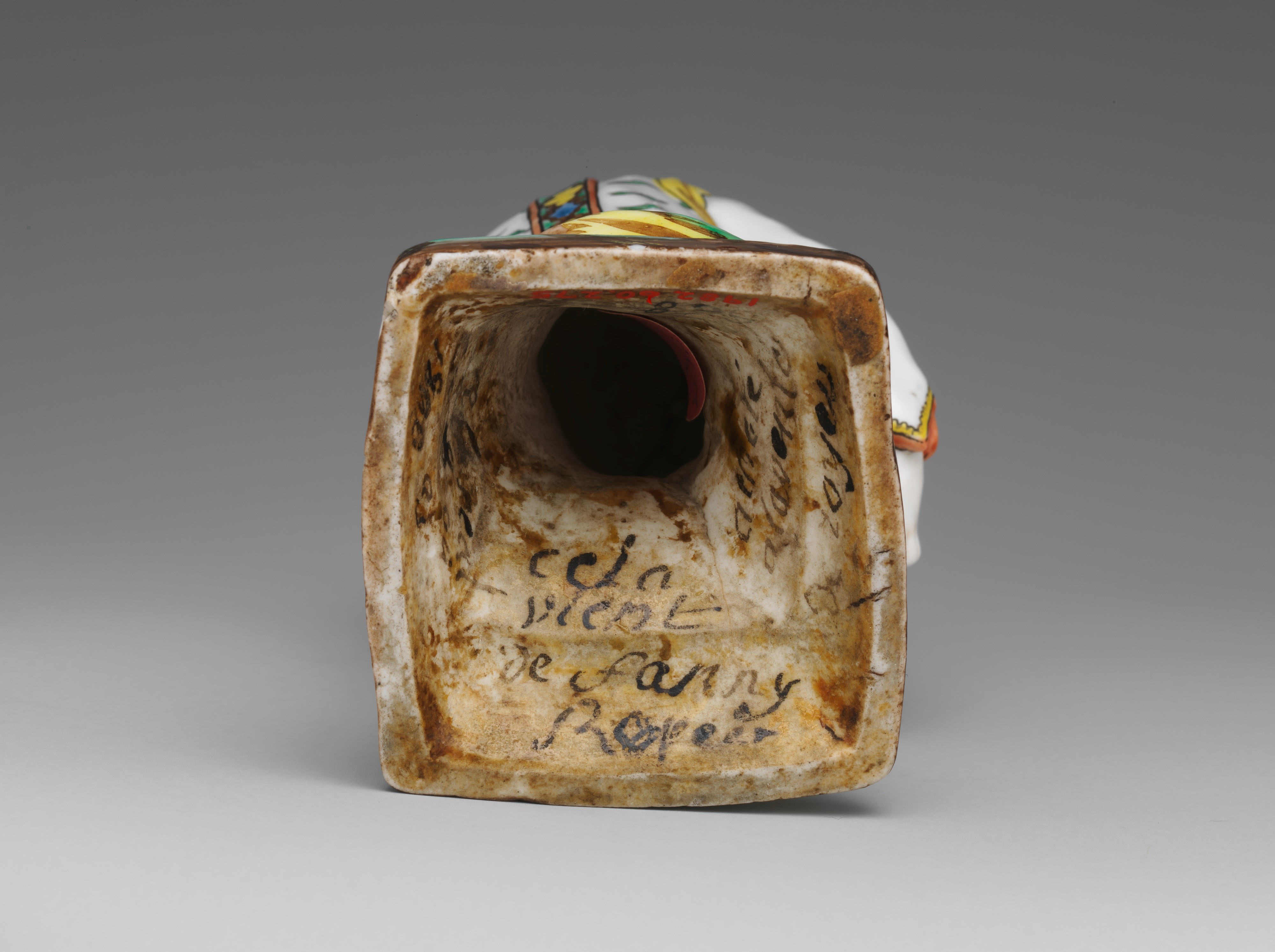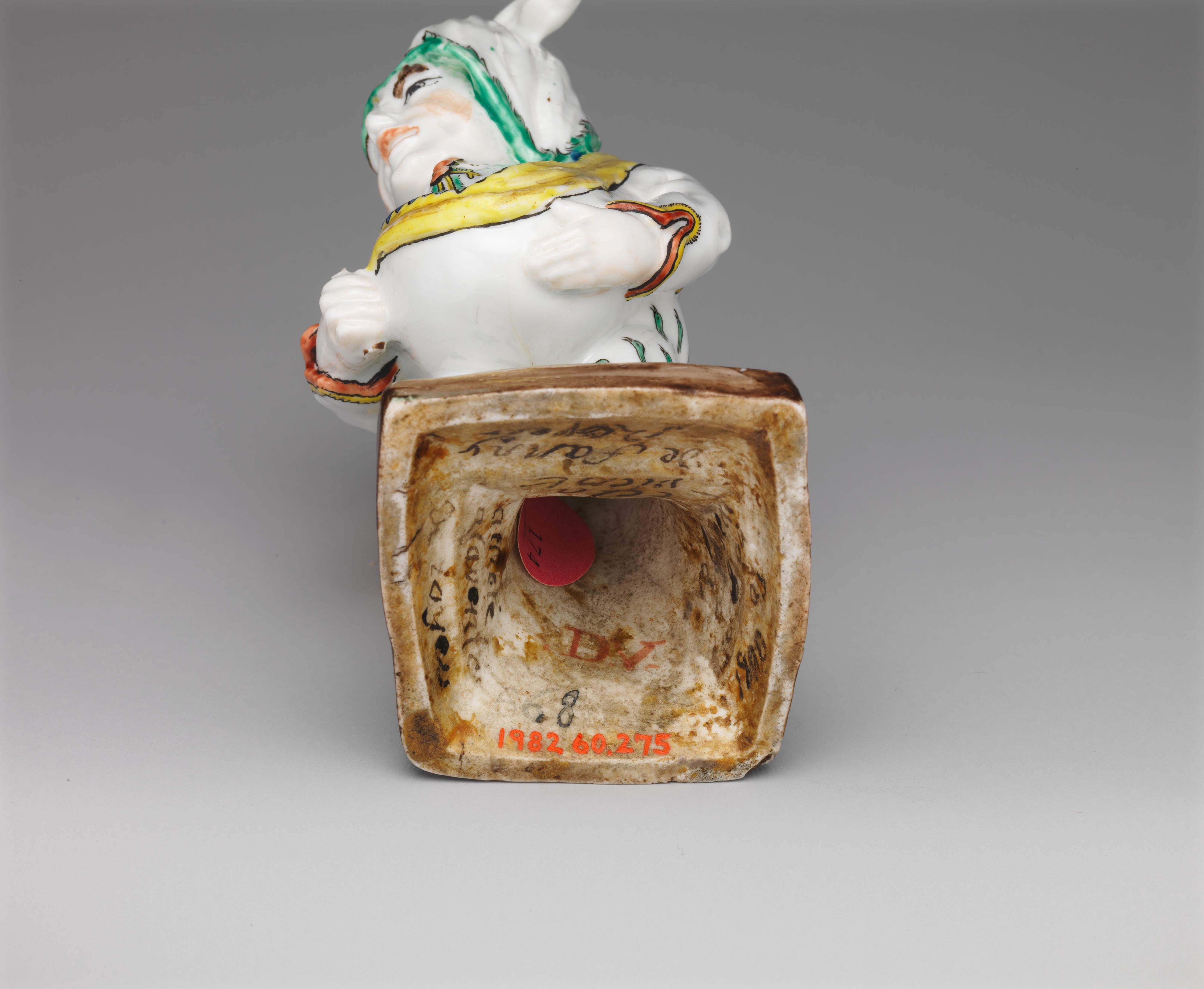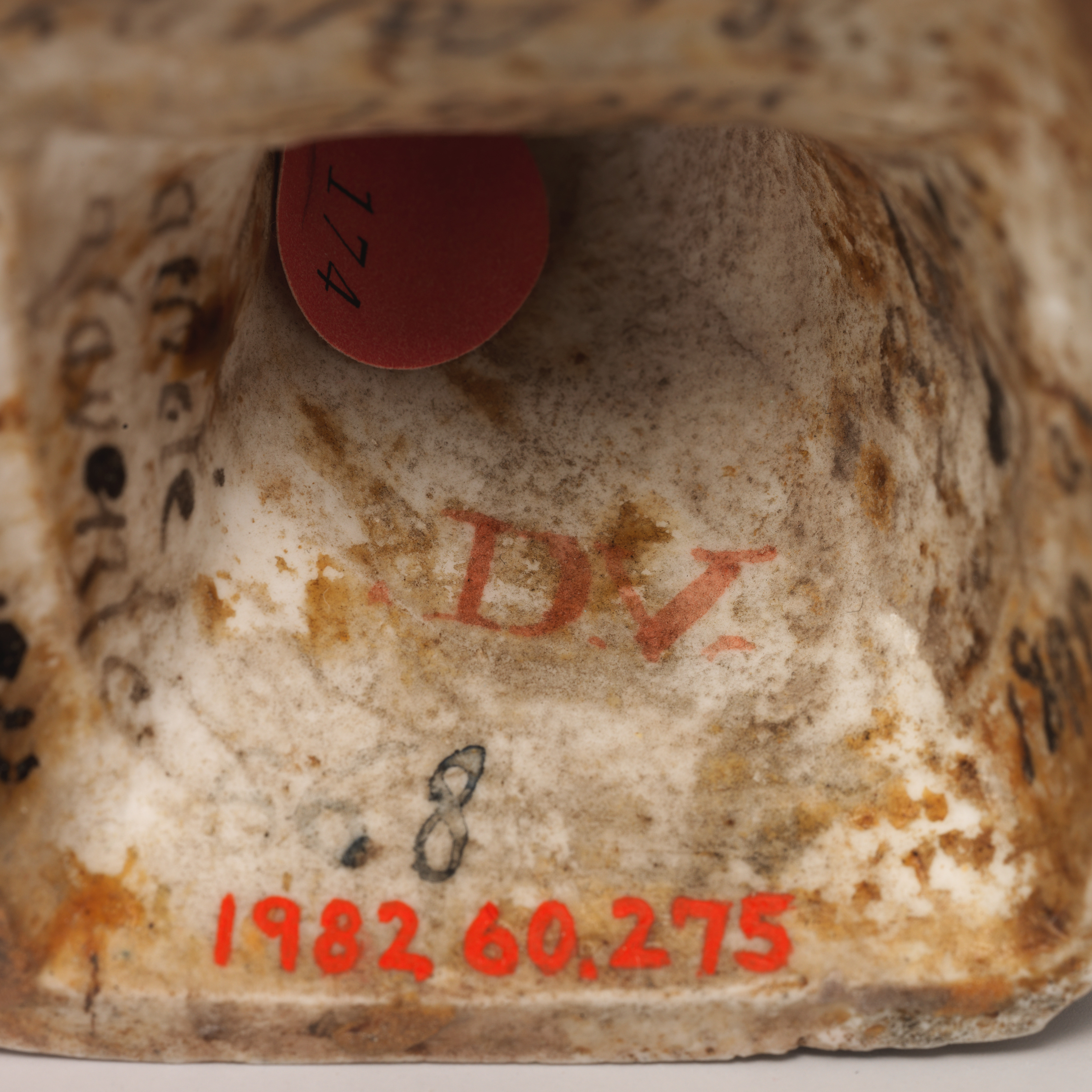Dwarf (one of a pair)
Manufactory Villeroy French
After a print by Jacques Callot French
The Villeroy factory produced a limited number of figures, and most if not all of these fall into two main categories: depictions of “Chinese” figures, most of whom are boys;[1] or of dwarfs, some of whom are also hunchbacks. While it may seem surprising today, the figures of dwarfs made by the factory appear to have been more popular than the chinoiserie figures, given the variety of models of dwarfs produced [2] and the number of surviving examples. Some of the dwarflike figures made at Villeroy cannot be easily classified as either dwarfs or hunch-backs, but the obviously unusual proportions of the figures and their facial features indicate that the depictions were intended to represent those with some type of physical deformity.[3]
As was true of most of the production at Villeroy, a tin glaze has been used for these two dwarfs, and each figure bears the letters D.V., a mark now commonly interpreted as that of the Villeroy factory (see 54.147.8).[4] Like many of the dwarfs produced at Villeroy, these two figures are derived from etchings by the French artist Jacques Callot (1592–1635). Callot’s Varie Figure Gobbi was published in 1616,[5] and this suite of twenty etchings depicting dwarfs and other small deformed characters, often known as grotesques, proved to be so popular that it was reissued throughout the seventeenth century. In the early eighteenth century, various editions of prints inspired by Callot’s Gobbi were published, the best known of which is Il Callotto resuscitato.[6] It is difficult to identify with certainty the specific source among these prints for the two Villeroy figures, but they ultimately derive from two plates in Callot’s Gobbi. The dwarf with the pronounced stomach (MMA 1982.60.276) is based upon the etching entitled Le Bossu à la canne,[7] while the dwarf with the upraised leg (MMA 1982.60.275) derives from the etching L’homme raclant un gril en guise de violon.[8] The porcelain modelers have taken certain small liberties, the most notable of which is the elimination of the cooking grill that the dwarf plays as an instrument in L’homme raclant. The porcelain version is depicted in the same pose but originally held only a cane, now missing. The figure derived from Le Bossu is closer to the printed original, but he too has lost his cane through breakage. The porcelain figures have been provided with supports in the form of stylized tree trunks that do not appear in the etchings, and the distinctive costumes of the Villeroy dwarfs, which include a pattern composed of bird heads, are the inventions of the factory’s painters. The relative spareness of the enamel decoration on both figures may reflect the factory’s intent to emphasize the whiteness of its tin-glazed porcelain body.
The Italian word gobbo that appears in plural form in Callot’s title means “hunchback,” and it seems very likely that Callot was inspired to create this suite of etchings from observing the troupes of dwarfs and hunchbacks that routinely performed popular entertainments in the early seventeenth century in Florence, where Callot spent the years 1612–22.[9] In his etchings, Callot has exaggerated the physical deformities of the figures, and his caricatures seem intended to amuse and entertain, just as the theatrical troupes of dwarfs aimed to do for their audiences in Florence. Dwarfs had long provided entertainment at European courts, as well as at popular fairs, and by the time Callot executed his etchings, images of dwarfs were commonly regarded as vehicles for satire and ribald humor. For the title page to Varie Figure Gobbi, Callot chose to depict six dwarfs lifting the shirt of a seventh to prominently expose his ample rear end, above which appears the suite’s title.[10]
Despite the popularity of representations of dwarfs into the eighteenth century in Europe, Villeroy was the only French porcelain factory to produce figures of dwarfs. However, numerous porcelain factories outside of France included dwarfs in their sculptural repertoire. The Meissen Manufactory made a wide range of dwarf figures in the mid-1720s,[11] and there is a small group of teapots, sugar boxes, and one waste bowl (for used tea leaves ) made at Meissen in the early 1720s that are decorated with dwarfs, some of whom are depicted in equestrian scenes that are notable for the earthiness of their humor(see 02.5.39a, b).[12] Meissen also made a series of mugs in the mid-1740s decorated with scenes depicting the months of the year and with images of dwarfs in various activities.[13] The popularity of dwarfs produced in porcelain persisted into the second half of the eighteenth century, with examples made at Mennecy,[14] Doccia,[15] possibly Capodimonte,[16] Vienna,[17] and at Höchst,[18] among other factories.
While it is not certain how the Villeroy dwarfs were intended to be used, it is likely that the figures were produced to be incorporated into small-scale, gilt-bronze furnishings, such as inkstands,[19] candelabra,[20] or clocks. There are numerous examples of bronzes d’ameublement (as this category of decorative objects was known) that incorporate porcelain animals or chinoiserie figures, and it appears that figures of dwarfs, unencumbered by the political sensitivity prevalent today, were regarded as yet another category of fanciful porcelain sculpture to be employed for decorative purposes.
Footnotes
(For key to shortened references see bibliography in Munger, European Porcelain in the Metropolitan Museum of Art. NY: The Metropolitan Museum of Art, 2018)
1 See, for example, Le Duc 1996, ill. p. 315.
2 Eleven models have been identified by the author, which is the same figure published by Clare Le Corbeiller (in Roth and Le Corbeiller 2000, p. 63). Determining a precise number of models is complicated by the fact that some of the figures may have been produced either at Villeroy before the factory closed in 1748 or shortly after the successor factory was established at Mennecy in 1750.
3 For examples, see Vivian S. Hawes in Hawes and Corsiglia 1984, pp. 165–67, no. 55.
4 Three additional models of dwarfs are also part of the Jack and Belle Linsky Collection at the Museum, all of which are tin glazed and one of which is also marked D.V. See Le Corbeiller in Metropolitan Museum of Art 1984a, pp. 312–14, nos. 281, 282, 285.
5 For more information on the Gobbi, see Daniel Ternois in Jacques Callot 1992, p. 227.
6 The history of these later publications is succinctly summarized by Le Corbeiller in Metropolitan Museum of Art 1984a, p. 312.
7 Jacques Callot 1992, p. 228, no. 174.
8 Ibid., p. 230, no. 188.
9 Ternois in ibid., p. 227.
10 See Lieure 1989, vol. 2, no. 279, Les Gobbi, ill. (see nos. 407–26).
11 Melitta Kunze-Köllensperger in Pietsch and Banz 2010, p. 182, no. 40.
12 T. H. Clarke 1988.
13 Blaauwen 2000, pp. 322–23, no. 231.
14 Dawson 1996, p. 46, no. 33.
15 Munger 2007a, fig. 14.
16 Le Corbeiller in Metropolitan Museum of Art 1984a, p. 315, no. 288.
17 Le Corbeiller in ibid., p. 280, no. 214.
18 Le Corbeiller in ibid., p. 314, no. 287.
19 See, for example, Watson 1966, pp. 468–69, no. 264.
20 See, for example, Honey 1950, pl. 44B.
Due to rights restrictions, this image cannot be enlarged, viewed at full screen, or downloaded.
This artwork is meant to be viewed from right to left. Scroll left to view more.





